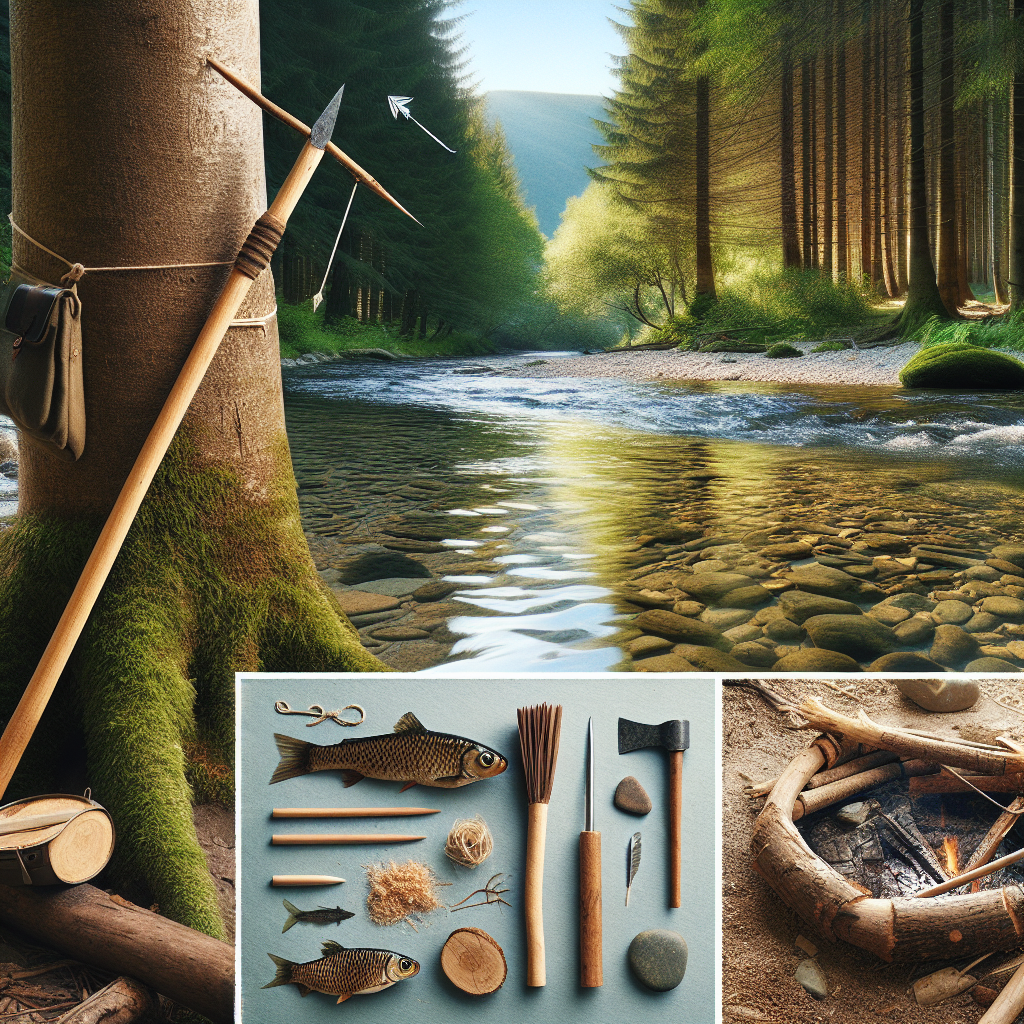You’re about to discover a fascinating skill that will not only enhance your survival techniques but also allow you to become a proficient angler and protector. In this article, we will guide you through the step-by-step process of making your own spear for both fishing and defense. From selecting the right materials to assembling the spear with ease, you’ll soon be equipped with a valuable tool that can serve multiple purposes in the great outdoors. Get ready to unleash your inner hunter-gatherer as we embark on this exciting journey together.

Essential Tools and Materials
To begin your journey in crafting your own spear for fishing and defense, it is important to gather all the necessary tools and materials. Having the right equipment ensures a smooth and successful spear-making process.
Types of Spears
Before you dive into the process, it’s vital to understand the different types of spears available. Broadly speaking, there are two main categories: hand-thrown spears and spears that are used with a throwing device, such as an atlatl or spear thrower. Each type has its own advantages and purposes, so it’s crucial to choose the spear that best suits your needs.
Choosing the Right Wood
Selecting the appropriate wood for your spear is integral to its durability and functionality. Ideally, you should opt for hardwoods like ash, hickory, or oak. These woods have proven to possess the necessary strength and flexibility required for a reliable spear. Avoid softwoods such as pine or cedar, as they tend to be less sturdy and prone to breakage.
Additional Materials
In addition to the wood, you will need some additional materials to complete your spear. These include a spearhead, cordage or fishing line, hooks, sinkers or weights, sandpaper, a finishing coat, and waterproofing material. By gathering these materials beforehand, you can ensure a seamless assembly process later on.
Tools Required
To transform your chosen wood into a formidable spear, you will need a few essential tools. These include a saw or hatchet for cutting the wood to the desired length, carving knives or chisels for shaping the spearhead, a drill for making holes, sandpaper for smoothing out rough edges, and perhaps some basic woodworking tools for any additional fine-tuning. With these tools at your disposal, you’ll have everything you need to get started.
Preparing the Wood for the Spear
Now that you have all the necessary tools and materials, it’s time to prepare the wood for your spear. This phase involves selecting the right wood, removing bark and splinters, and shaping the wood to achieve the desired form.
Selecting the Wood
Choosing the right wood is a crucial step in creating a durable and reliable spear. As mentioned earlier, hardwoods such as ash, hickory, or oak are excellent options due to their strength and flexibility. Aim for a straight piece of wood that is approximately five to six feet long and about an inch in diameter.
Removing Bark and Splinters
Before shaping the wood, it’s important to remove any bark or splinters that may interfere with the spear-making process. Use a knife or a scraper to carefully strip away the bark, ensuring a smooth surface for carving and handling. Be cautious not to remove too much wood during this process, as it may compromise the integrity of the spear.
Shaping the Wood
Once the wood is free from bark and splinters, it’s time to shape it into a functional spear. Begin by crafting a pointed end on one side of the wood, which will serve as the spearhead. Use a saw or hatchet to carefully shape the wood, maintaining a gradual taper towards the point. Take your time during this process, as precision is key to ensure proper balance and aerodynamics.
Creating the Spearhead
The spearhead is a vital component of any spear, as it determines its effectiveness in both fishing and defense. In this section, we will discuss the process of choosing the right spearhead style, selecting the appropriate materials, and shaping the spearhead to perfection.
Choosing the Spearhead Style
There are various styles of spearheads to choose from, each with its own advantages and applications. Common spearhead styles include leaf, barbed, and broadhead. Determine your specific needs – whether it’s for fishing or self-defense – and select a spearhead style that best suits your intended purpose.
Materials for the Spearhead
Once you have chosen the spearhead style, it’s time to gather the necessary materials. Traditional spearheads were made from sharpened stones or bones, but modern alternatives such as stainless steel or high-carbon steel are commonly used. Select a material that combines strength, durability, and ease of shaping.
Shaping the Spearhead
With your chosen material in hand, it’s time to shape your spearhead. This step requires precision and patience, as you want to ensure a sharp and balanced spearhead. Use carving knives or chisels to carefully sculpt the desired shape, maintaining an edge that is both formidable and functional. Take your time during this process, as a well-crafted spearhead significantly enhances your spear’s effectiveness.
Attaching the Spearhead to the Shaft
Now that you have crafted your spearhead and prepared the wood shaft, it’s time to bring them together. This section will guide you through the process of drilling a hole in the spear shaft and properly fitting the spearhead.
Drilling a Hole in the Spear Shaft
To attach the spearhead to the shaft, you will need to drill a hole near the tapered end of the wood. Use a drill with a bit that matches the diameter of your spearhead tang, ensuring a snug fit. Be cautious not to drill too close to the tip, as this may weaken the integrity of the spear.
Fitting the Spearhead
Once the hole is drilled, carefully slide the spearhead tang into the hole, making sure it fits securely. You may need to use epoxy or adhesive to ensure a strong connection. Take your time with this step to guarantee a secure and durable assembly.

Finishing and Waterproofing the Spear
To protect your spear from moisture and extend its lifespan, it’s essential to undertake a few finishing touches. In this section, we will cover sanding the spear, applying a finishing coat, and waterproofing the spear.
Sanding the Spear
Before applying any finish or waterproofing materials, it’s crucial to sand the spear. Use sandpaper with a medium to fine grit to smooth out any rough edges or imperfections. Sanding helps achieve a sleek and polished surface, ensuring a comfortable grip and enhanced functionality.
Applying a Finishing Coat
To further protect the wood and enhance its appearance, consider applying a finishing coat. Finishing coats, such as varnish or polyurethane, provide an additional layer of defense against moisture, scratches, and general wear and tear. Be sure to follow the manufacturer’s instructions for application and allow sufficient drying time.
Waterproofing the Spear
Waterproofing your spear is a vital step, especially if you plan to use it for fishing purposes. Apply a suitable waterproofing material, such as marine-grade epoxy or sealant, to the spearhead and the lower section of the shaft. This protective layer helps prevent water absorption and reduces the risk of warping, ultimately enhancing the overall durability of your spear.
Preparing the Spear for Fishing
Now that your spear is crafted, it’s time to prepare it specifically for fishing. This section will discuss securing fishing line, attaching hooks, and adding weights or sinkers.
Securing Fishing Line
To transform your spear into a fishing tool, attach a length of fishing line to it. This can be achieved by securely tying one end of the fishing line around the shaft, just below the spearhead. Ensure the knot is tight and reliable, as it will play a crucial role in securing your catch.
Attaching Hooks
To increase the chances of catching fish, attach hooks to the fishing line. Use a strong and reliable knot, such as a Palomar knot, to secure the hooks at regular intervals along the line. Consider using barbed hooks for increased effectiveness in hooking the fish.
Adding Weight or Sinkers
Depending on your fishing style and target species, you may need to add weights or sinkers to your spear. These additions help the spear descend in the water and increase its striking power. Thread the fishing line through the sinkers and secure them at suitable intervals above the hooks. Experiment with different weights until you find the optimal balance for your fishing needs.
Using the Spear for Fishing
Now that your spear is specifically prepared for fishing, it’s time to put it to use. Before heading out to your fishing spot, familiarize yourself with selecting the right location, proper throwing technique, and handling and retrieving your catch.
Selecting the Right Spot
When using a spear for fishing, it’s important to choose the appropriate location. Look for areas with sufficient water depth and visibility, as these factors greatly affect your chances of success. Shallow, clear waters near rocky outcrops or reefs often attract an abundance of fish, making them ideal spots to try your hand at spearfishing.
Proper Technique for Throwing the Spear
To effectively catch fish with your spear, it’s crucial to master the proper throwing technique. Stand with your dominant foot slightly ahead of the other, with your body facing the water. Grip the spear firmly, with your throwing hand positioned toward the back end of the spear. As you release the spear, aim for your target and throw with a smooth, fluid motion. Practice is key to honing your throwing skills, so don’t be discouraged if it takes some time to achieve accuracy.
Handling and Retrieving the Catch
Once you have successfully struck your target, it’s important to handle and retrieve the catch with care. Be cautious of the fish’s sharp spines or teeth, as they can cause injury. Use a net or your free hand to secure the fish, and gently remove it from the water. Ensure your grip is firm but not overly tight, as you want to avoid causing unnecessary harm to the fish or risking injury to yourself.
Utilizing the Spear for Self-Defense
Aside from its fishing applications, a spear can also serve as a formidable tool for self-defense. In this section, we will discuss understanding self-defense situations, gripping and handling the spear, and defending against an attacker.
Understanding Self-Defense Situations
When utilizing a spear for self-defense, it’s crucial to have a clear understanding of the situations in which it may be necessary. Keep in mind that self-defense should only be employed when absolutely necessary to protect yourself or others from imminent harm. Familiarize yourself with local laws and regulations, and be mindful of the potential consequences of using a spear in a self-defense scenario.
Gripping and Handling the Spear
Proper grip and handling of the spear are vital to optimizing its effectiveness as a self-defense tool. When held for self-defense purposes, grip the spear firmly with both hands, placing one hand near the spearhead and the other a comfortable distance away. This grip allows for better control and maneuverability, enabling you to defend yourself effectively.
Defending Against an Attacker
In the unfortunate event that you find yourself needing to defend against an attacker, keep calm and focused. Use the length and reach of the spear to your advantage, maintaining distance between yourself and the attacker. Aim for vital and vulnerable areas, such as the abdomen, legs, or arms. Remember, the primary goal is to create an opportunity to escape the situation safely.
Maintenance and Care
Proper maintenance and care are crucial to ensure the longevity and functionality of your spear. In this section, we will discuss cleaning and drying the spear, repairing damages, and sharpening the spearhead.
Cleaning and Drying the Spear
After each use, it’s important to clean your spear thoroughly. Rinse it with freshwater to remove any saltwater or debris that may have accumulated. Dry the spear completely before storage, as moisture can lead to rust and compromise its integrity. Regular cleaning and drying help prevent corrosion and maintain your spear in optimal condition.
Repairing Damages
Over time, your spear may encounter wear and tear, resulting in damages that need repair. If the wood shaft becomes cracked or damaged, consider using wood filler or epoxy to mend any imperfections. If the spearhead becomes loose or shows signs of damage, remove it, repair or replace it as necessary, and securely reattach it to the shaft. Regular inspection and prompt repairs ensure that your spear remains reliable and functional.
Sharpening the Spearhead
To maintain the sharpness and effectiveness of your spearhead, regular sharpening is essential. Use a sharpening stone or a whetstone to carefully hone the spearhead until it regains its optimal sharpness. Take your time while sharpening, ensuring an even edge and maintaining the desired shape of the spearhead. A sharp spearhead significantly improves your chances of successfully catching fish or defending yourself.
Conclusion
Congratulations! You have completed your comprehensive guide on how to make a spear for fishing and defense. By following the steps outlined in this article, you have equipped yourself with the knowledge and skills to create a reliable tool that serves multiple purposes.
Remember to exercise caution and adhere to local laws and regulations when using a spear for fishing or self-defense. With proper maintenance, care, and practice, your spear will become a trusted companion in your outdoor adventures, be it catching fish or ensuring your personal safety. Enjoy your newfound skill and embark on exciting journeys with your own handcrafted spear!

